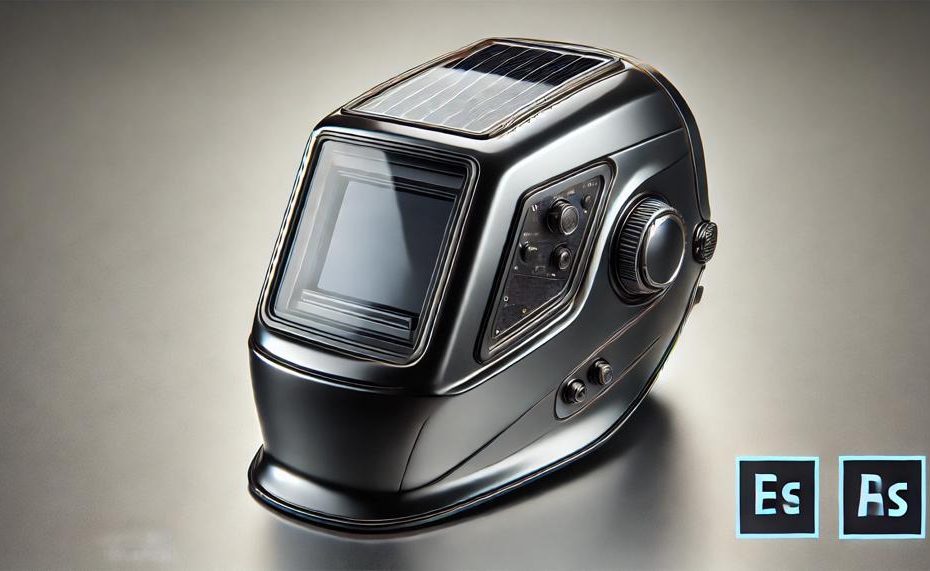In the world of welding, where the bright flare of the torch meets metal, innovation shines just as brightly behind the mask. Enter the solar-powered welding helmet, a game-changer for the modern welder that marries the ancient craft of welding with cutting-edge technology. As we peel back the layers of this remarkable device, we invite you on a journey through the mechanics, benefits, and sheer brilliance of solar-powered welding helmets. Our exploration is crafted for both the seasoned professional and the curious novice, aiming to shed light on:
- The Basics: Understand what solar-powered welding helmets are and how they distinguish themselves from traditional welding masks.
- The Mechanics: Dive into the inner workings, exploring the solar panels, auto-darkening technology, and how these helmets harness the sun’s power.
- The Benefits: Discover the advantages for welders, including enhanced safety, improved efficiency, and eco-friendliness.
- Why It Matters: Uncover why this technology is not just a step forward for individual welders, but a leap for the industry as a whole.
Our guide promises a blend of engaging insights and practical advice, delivered in a tone that’s both casual and professional. Whether you’re a welding veteran or simply intrigued by how technology is transforming traditional crafts, this post will illuminate the importance and impact of solar-powered welding helmets in today’s welding landscape. Join us as we unveil the future of welding, one helmet at a time.
Contents
- 1 How Solar-Powered Welding Helmets Work?
- 2 The Advantages of Solar-Powered Welding Helmets
- 3 Disadvantages of Solar-Powered Welding Helmets
- 4 Here are some other elements that play a role in lifespan
- 5 How Long Solar-Powered Helmets Last
- 6 Which type of welder should use a solar-powered welding helmet?
- 7 Conclusion
How Solar-Powered Welding Helmets Work?
Solar-powered welding helmets are a marvel of technology, combining efficiency with safety to ensure welders are shielded from the blinding glare and harmful radiation of welding arcs. Here’s a breakdown of how these ingenious devices function:
Solar Panel and Power:
At the heart of a solar-powered welding helmet is the solar panel, ingeniously integrated into the design. This panel harnesses sunlight, converting it into electrical energy. This energy is pivotal, powering the auto-darkening feature of the helmet’s lens, which is essential for the welder’s eye protection.
Auto-Darkening Lens:
The auto-darkening lens, a critical component, is equipped with liquid crystal displays coated with polarizing material. When the helmet’s sensors detect a welding arc, the lens transitions from light to dark in milliseconds, safeguarding the welder’s vision from intense light and harmful radiation.
Adjustability for Comfort and Safety:
These helmets aren’t just about protection; they’re about personalization too. With adjustable sensitivity and delay settings, welders can tailor the helmet’s response to their environment and preferences, enhancing both safety and convenience.
Maintenance for Longevity:
To ensure these helmets serve welders well over time, regular maintenance is key. This includes keeping the lens clean and the helmet dry, essential steps to maintain performance and reliability.
In essence, solar-powered welding helmets are a welder’s ally, blending advanced technology with user-centric features to provide unrivaled protection and convenience.
The Advantages of Solar-Powered Welding Helmets
| Feature | Solar-Powered Welding Helmet | Traditional Welding Helmet |
| Power Source | Uses sunlight; no need for battery replacements | Relies on batteries; frequent replacements needed |
| Environmental Impact | Greener choice; reduces waste | Higher due to battery disposal |
| Lifespan | Longer, due to fewer parts that require replacing | Shorter, affected by battery life and durability |
| Visibility | Clearer lenses; better for precision work | Standard lenses; may hinder detailed tasks |
| Customizable Features | Adjustable settings for comfort and efficiency | Limited or no adjustable features |
| Weight | Light, enhances user comfort over long periods | Often heavier, leading to fatigue |
| Functionality | Auto-darkening improves safety and productivity | Manual adjustments required; slower to adapt |
| Versatility | Suitable for multiple tasks (welding, cutting, grinding) | Primarily for welding; less adaptable |
Opting for a solar-powered welding helmet brings a host of advantages over traditional models, spotlighting convenience, eco-friendliness, and versatility. These helmets sidestep the frequent battery changes, cutting down on waste and ongoing costs. They shine with longer lifespans and customizable options, allowing for a tailored welding experience. Enhanced visibility through larger, clearer lenses and lightweight designs promises comfort and precision, with the auto-darkening feature marking a significant leap in safety and efficiency.
Disadvantages of Solar-Powered Welding Helmets
Solar-powered welding helmets, despite their advantages in eco-friendliness and convenience, come with their own set of drawbacks. These helmets harness sunlight to power their auto-darkening filters, a technology that’s been a game-changer for welders worldwide. Yet, it’s crucial to cast a light on the less sunny side of their use.
- Dependency on Sunlight for Recharge: Solar-powered welding helmets require sunlight for recharging. This characteristic can limit their readiness and efficiency, especially in regions with low sunlight or for welders working indoors or during the night.
- Potential for Short Lifespan in Some Models: Not all solar-powered welding helmets are built equal. A number of them may boast a shorter lifespan, largely due to the quality of solar cells and the battery. This variability can transform what is often seen as a smart investment into a gamble.
- Delayed Start Time: Some welders have noted that solar-powered helmets can have a slight delay in waking up from a powered-down state. This momentary lag, although brief, could be a hindrance in situations where quick response times are critical.
While solar-powered welding helmets present a step forward in welding technology by promoting greener practices and offering convenience, it’s essential to weigh these benefits against their limitations.
For welders considering a solar-powered helmet, it’s wise to scrutinize the model’s specifications, read reviews, and, if possible, test the helmet before making a decision.
Here are some other elements that play a role in lifespan
When pondering the resilience of welding helmets beyond the realm of solar power, a myriad of elements come into play.

Each plays a pivotal role in ensuring these indispensable shields for welders stand the test of time and the rigours of their environment. Let’s dive into these factors with a bit of clarity and depth.
Handling Extreme Conditions and Rough Use
Welding helmets, akin to stalwart companions in the forge, face trials from both extreme temperatures and harsh environs.
Their materials must withstand scorching heat and occasional sparks, as well as the cold, without cracking under pressure.
Frequency and Care in Usage
How often you don the helmet and the care you bestow upon it significantly dictate its longevity. Regular maintenance, such as cleaning the lens and checking for wear and tear, can forestall its journey to the scrapheap.
Build Quality and Material Excellence
The constitution of your welding helmet—what it’s made of—matters immensely. Helmets crafted from robust, heat-resistant materials can brave the severe conditions of welding, ensuring they remain by your side, session after session.
Proper Stowage
A helmet’s sanctuary, when not in use, impacts its lifespan. Storing it away from harmful elements in a cool, dry place can stave off degradation, ensuring it’s ready for action whenever you are.
Synergy with Welding Gear
Finally, how well your helmet gets along with other welding paraphernalia influences its enduring capability. Compatibility ensures smooth operation and reduces the risk of damage due to mismatches in equipment standards.
In essence, the lifespan of welding helmets hinges on a symphony of factors, from how they’re treated and maintained to the very essence of their creation.
How Long Solar-Powered Helmets Last
The durability of a solar-powered welding helmet, a shield against the harshness of UV and IR rays during the craft of welding, hinges not just on its build but on the care it receives from its wielder.
A well-maintained helmet can be a steadfast companion for upwards of 5 to 7 years. Below, find a table that outlines key practices to extend your helmet’s service life, ensuring it remains a reliable guardian in your welding endeavours.
| Action | Reason | Frequency |
| Clean the lens | To maintain clear vision and prevent damage from debris | After each use |
| Keep dry and away from moisture | To prevent electronic damage | Continuously |
| Charge in sunlight | To ensure the solar cells are powered | Before use if not used regularly |
| Replace batteries (if applicable) | To maintain optimal functionality | Every 2-3 years or as needed |
| Store properly | To avoid unnecessary wear and tear | After each use |
It’s not just about the maintenance; the journey of a solar-powered welding helmet is also about the adventures it has seen and the tales it could tell. From the intensity of a high-grade steel joining to the delicate touch needed for aluminium, every flash of light it shields your eyes from is a note in its symphony. To ensure this steadfast companion stands the test of time, embrace the rituals of care outlined above.
Which type of welder should use a solar-powered welding helmet?
Any welder can harness the benefits of a solar-powered welding helmet, but it especially shines for those frequently working outdoors or in well-lit environments.
These helmets are tailored for welders who appreciate sustainability, long-lasting gear without the fuss of frequent battery changes, and who might vary their welding tasks, needing adjustable settings for optimal protection and clarity.
Benefits of Solar-Powered Welding Helmets:
- Efficiency and Convenience: Utilizes solar panels, harnessing sunlight to power the auto-darkening lens.
- Longevity: Sunlight-charged, negating constant battery replacement, ideal for lengthy projects.
- Safety: Offers staunch protection against harmful radiations and intense light.
- Comfort: Lightweight design mitigates fatigue, enhancing wearer comfort over long durations.
- Eco-Friendly: A nod to environmental consciousness, reducing carbon footprint.
- Adaptability: Adjustable lens settings cater to varied welding tasks, ensuring precise protection.
Ideal Users for Solar-Powered Welding Helmets:
| Outdoor Welders | Benefit from constant solar charging, ideal for their sun-exposed working conditions. |
| Versatile Welders | Those who perform a variety of welding tasks, needing adjustable lens shade and sensitivity. |
| Eco-Conscious Welders | Individuals prioritizing environmentally friendly tools, minimizing waste from batteries. |
| Long-Haul Welders | Professionals engaged in prolonged projects, where consistent helmet readiness is key. |
In essence, while any welder can adopt this advanced headgear, those stationed outdoors, tackling a spectrum of welding activities, or leaning towards green practices stand to gain the most.
Conclusion
As we stand at the crossroads of tradition and innovation in the welding world, solar-powered welding helmets emerge as a beacon of progress. These helmets are not just protective gear but a fusion of ancient craftsmanship and contemporary technology. They offer a glimpse into the future, where efficiency, safety, and environmental consciousness converge to redefine the welding experience.
At their core, solar-powered welding helmets are powered by the sun, making them an eco-friendly alternative to their battery-operated counterparts. They boast auto-darkening lenses that adapt in milliseconds to protect welders from harmful radiation and intense light, a feature that enhances both safety and productivity. This adaptability is further complemented by customizable settings, allowing welders to fine-tune their helmets for different environments and tasks. Maintenance, crucial for longevity, underscores the helmets’ design with simplicity and durability in mind.
The comparison between solar-powered and traditional welding helmets highlights a clear shift towards more sustainable, efficient, and versatile welding practices. Solar-powered helmets not only reduce waste and operational costs but also offer improved visibility and comfort, which are essential for precision work and long hours on the job.
Despite their numerous advantages, it’s important for welders to consider the few drawbacks, such as dependency on sunlight and potential variability in lifespan. However, with proper care and consideration, these helmets stand as a testament to the evolution of welding gear, offering a blend of protection, convenience, and respect for the planet.
In embracing solar-powered welding helmets, welders are not just choosing a piece of equipment; they are stepping into a new era of welding that honors the craft’s past while boldly facing the future.





